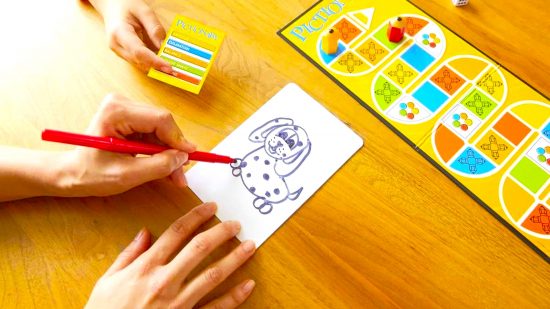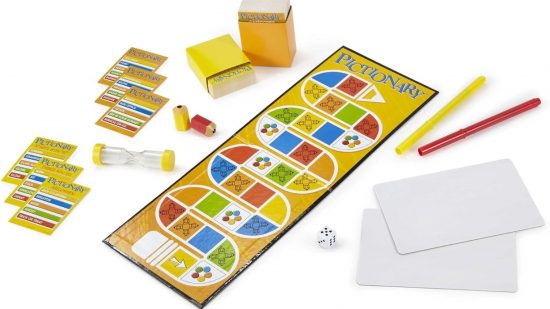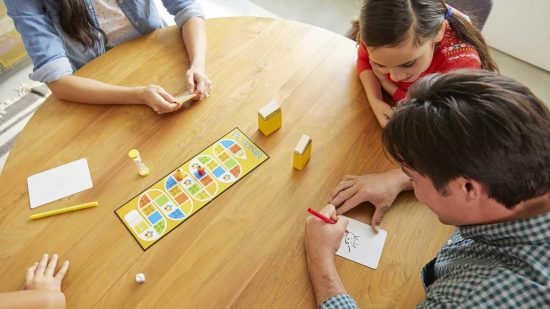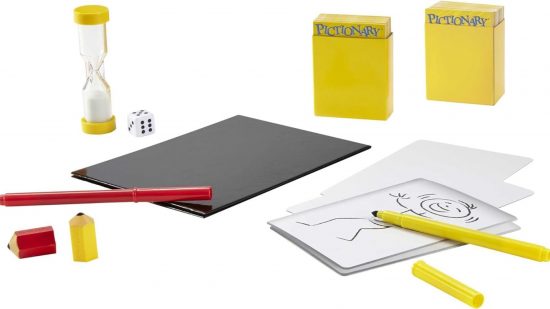Learning how to play Pictionary can be as easy as drawing a cloud. While this popular party game will challenge you to draw (and guess) more complex concepts, learning Pictionary rules doesn’t need to be quite so unclear. Simply pick up a pencil and pad, switch on your brain, and let us walk you through the steps of Pictionary.
If you find love Pictionary, the first game in our list of the ultimate best board games available is sure to be up your street. For more drawing fun, though, we can suggest a ton of our favorite Pictionary words for inspiration, or even the best variant Pictionary games to try. For now, we’ll be focusing on the rules for the 1985 original.
Here’s how to play Pictionary for beginners:
What is Pictionary?
In the simplest terms, Pictionary is a word-guessing game. One person must draw a randomly-decided prompt (think ‘bird’ or ‘fax machine’), and their teammates must attempt to guess what the image represents.
This being one of the best board games of the ‘80s, Pictionary also involves board, dice, and cards. Roll the dice to move to a square on the board – the board decides the category of word to select from the cards (more on these later), and the cards give you your prompts. Be the first team to reach the board’s ‘Finish’ square, and you win the game!
Pictionary setup
Setting up your Pictionary board is as simple as unboxing it. Make sure everyone can reach the board, die, and card box. Also, take the category reference cards out of the card box and split them among the players.
Pictionary typically comes with four playing pieces, four paper pads, and four pencils. Divide your players into two to four teams, and hand out the equipment equally.
Each team begins the game by placing their piece on the board’s ‘Start’ square and deciding who will be the first ‘picturist’ – the one that’ll be drawing first. After that, teams roll off to see who will go first, with the highest result deciding the starting player/s.
On their first turn, this team does not roll the die to move. They’ll instead begin a round of Pictionary in the ‘All Play’ category.
Pictionary Categories
Pictionary words fall under five categories:
- All Play (AP) – Any kind of word or phrase
- Difficult (D) – Particularly challenging words or expressions
- Actions (A) – Verbs, i.e. activities, occurrences, or states of being
- Person/Place/Animal (P) – Nouns, including proper names
- Object (O) – Also nouns, but inanimate ones that can be touched or seen
Squares on the board each represent one of these categories (each will have a distinct color – refer to your category reference card during the game). Some versions of Pictionary also come with a blank square that allows a picturist to choose which word and category they wish to draw from a card.
Pictionary rules
Here’s what to remember during a game of Pictionary:
Playing a turn
First, the picturist chooses a card from the front of the deck and examines the word that corresponds with the category square the team’s piece is currently in. They only have a limited time to review their word (according to Hasbro, five seconds is standard). The timer is turned over, and the picturist must sketch the prompt for the guessing team/s.
When a word is guessed correctly, the picturist’s team rolls the die and moves forward a number of squares equal to the die’s result. A new picturist is chosen from the team, and they choose a new card and word based on their new category square. The timer is turned again to give the team 60 seconds for each new word they attempt to guess, but their turn ends if the timer ever runs out.
When the team’s turn is over, the new team begins their turn in the same way (crucially, not by rolling the die before guessing begins – you only get to move forward after a correct guess).
Rules for drawing
When drawing, the following rules apply:
- Picturists can’t use words or actions to help their team guess what the drawing represents
- Letters and numbers cannot be included in the drawing
- You can draw an image that represents a homophone, e.g. flour and flower
- You can’t draw any clues that don’t directly relate to the prompt, e.g. an ear to tell your team the image ‘sounds like’ something
- Drawing and guessing can both continue until time is up or the word is guessed correctly
Rules for All Play
If a team is on an All Play square, things work slightly differently. During All Play, a picturist from both teams is shown the same prompt on a card. They must then simultaneously draw the same word, and the first team to identify the image gets to roll the die and move their piece forward on the board.
If neither team guesses the All Play word in time, play passes to the left as normal.
How to win Pictionary
As we said earlier, a team wins Pictionary by being first to reach the end of the squares on the board. But that’s not all – they must also correctly guess a final word as dictated by the square. Often, the final square is an All Play.
Fail to do so, and they’ll need to repeat this their next turn before they can win. This might give their rivals time to catch up, or even overtake them.
How to play Pictionary with three players
If you only have three players, you can’t form equal teams – but you can still play Pictionary. One player is chosen to be the picturist for both teams, and the role of picturist doesn’t change for the entire game.
For more classic board game rules, here’s how to play chess and how to play dominoes. If those get boring, you can always heat things up with our 150+ home grown, spicy Truth or Dare questions.




